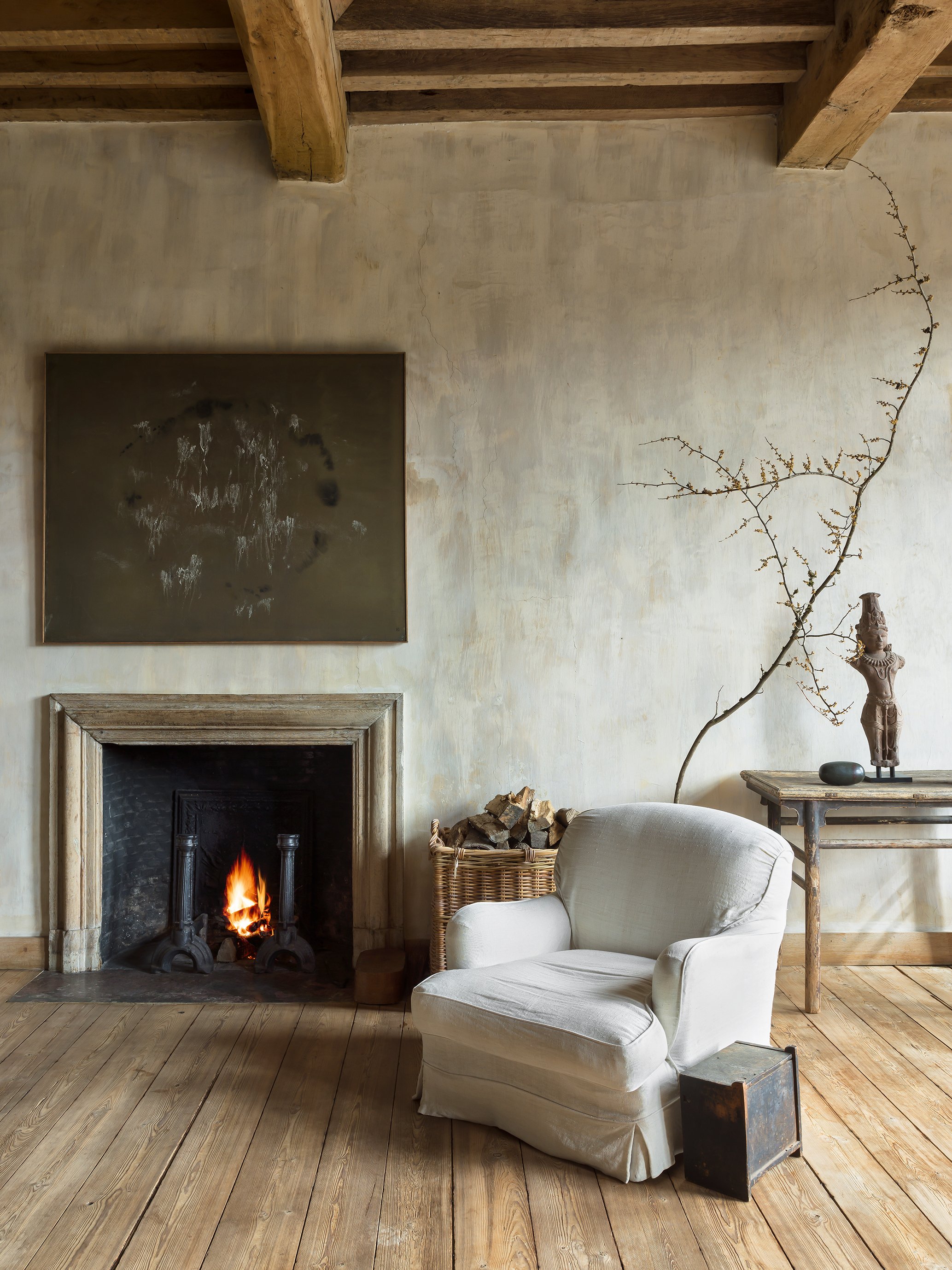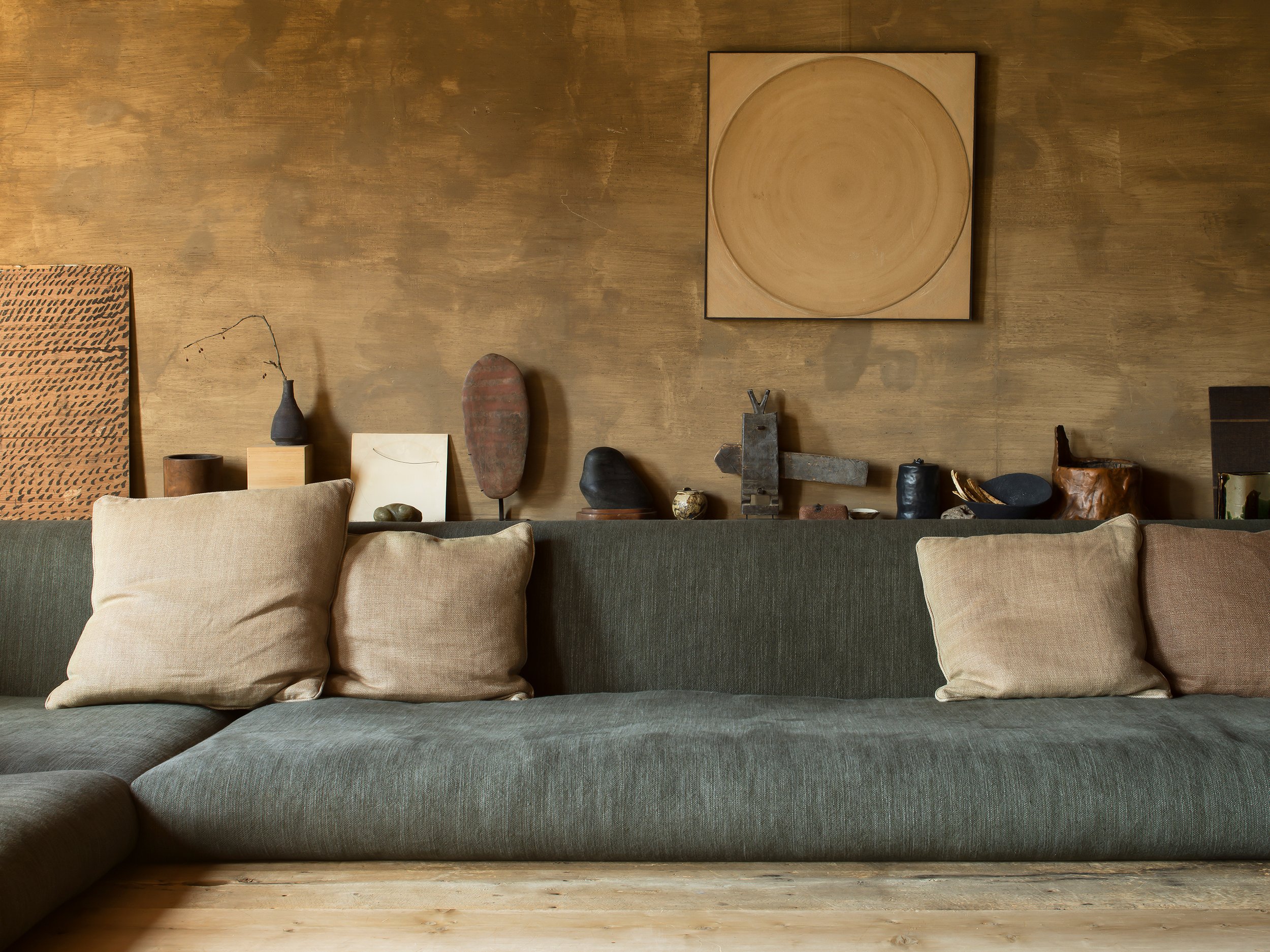The histories of space
Axel Vervoordt
The rooms of Castle‘s-Gravenwezel each tell a story about the influences and inspirations of Axel Vervoordt, the Belgian multi-hyphenate creator who calls the medieval castle just outside of Antwerp his home. Throughout a storied fifty-year-plus career, Vervoordt has built a reputation as a designer, dealer, collector, curator, and original inventor of space and style. Here, he opens up an insight into his personal history through the objects and artworks he chooses to live with.
Words by Axel Vervoordt as told to Michael Gardner
Photography: Piet Albert Goethals
Even on a rainy day, there are moments of light. That’s why I’ve always said that while we’ve lived here, I think there is always good weather in Belgium.
I first saw the Castle ‘s-Gravenwezel in 1984. From the very first instant we laid eyes on it, my wife May and I were convinced that it would be the ideal home for our family for the rest of our lives. I couldn’t believe it was possible that a property like this existed so close to the city of Antwerp. It’s a moated, medieval castle that was first mentioned in the historical record in 1108. Before we were able to acquire it, the castle hadn’t been on the market since 1729. The first image depicts the south part of the castle as viewed from the park. Set within about 72 hectares of land, the castle is surrounded by trees, but the beauty of the setting is that there isn’t a single tree that blocks the sun. We see the sunrise. We see the sunset. Even on a rainy day, there are moments of light. That’s why I’ve always said that while we’ve lived here, I think there is always good weather in Belgium.
The property includes several side buildings, and this space has become almost like a sculpture gallery that we use to host concerts and dinners for large groups of friends. I’ve always been attracted to art and objects from all periods and seeing contemporary works in dialogue with old pieces. Here, there’s a beautiful sculpture made of wax by Berlinde De Bruyckere. She’s an artist from Ghent and she made this work for one of the exhibitions I curated at Venice’s Palazzo Fortuny called ‘Artempo’ that explored the aspect of time in art. In the exhibition, Berlinde’s work engaged in a dialogue with a powerful painting by Francis Bacon. On the left is a vase, which is one of a pair that I acquired soon after moving to the castle. The vases were made by Jan Pieter van Baurscheit the Younger, a great architect and sculptor who was born in Antwerp and active in the 1700s. Because this south part of the castle existed from the 1720s onwards, I think the vases have an ideal home here as they are from that period.
Everything we transformed in the castle was to make it a home – more liveable – with an atmosphere adapted to our style of life. The renovations took two years, from 1984 to 1986. The castle’s entrance hall was initially painted grey, but it left me feeling a bit sad. Shortly after moving in, we changed it. I feel the hall of a big castle, or any home should belong to the landscape where it’s built. To achieve this, we used a combination of earth with natural pigments to paint the walls. We began with one layer of brown earth as the foundation, followed by a big layer of yellow earth mixed with lime. In our family’s first home in the Vlaeykensgang, I worked with a Moroccan painter named Abdel, who was a long-time collaborator and a passionate expert in materials. He painted this hall, and in the beginning I thought it looked too rustic. However, eventually the materials evolved, and the various tones and shades became present. Our close friend and collaborator, Eddy Dankers, who was a young painter from the Antwerp School of Painting at the time, painted the faux marble around this. In a way, the combination of the two is genuine, original, and sophisticated, more in the spirit of a castle. I love the presence of all these things together.
If you can believe it, this space used to be a billiard room. We removed the 19th-century furniture and stripped the wallpaper, as well as the plaster from the ceiling. We also took away the carpets to expose the bare wood floor. I’m attracted to the idea of travelling in a home. Moving from one atmosphere to the next – from full rooms with lots of objects, to empty rooms that create space for the mind.
The castle’s wabi room uses local brown earth as painting material and the entire space is designed like an intervention. All the elements can be removed immediately. We didn’t damage or harm any of the original, historical architectural elements when we installed it. The word wabi comes from the Japanese concept of wabi-sabi, which is a philosophy that embraces imperfection, irregularity, and impermanence. My way of wabi is a deep respect for nature, simplicity, and humility. The wooden beam here is called a tokonobashi. It’s a beam that symbolizes wisdom and old age. It doesn’t provide functional or structural support. It’s just present. Like an old tree, it leans and shows its age as a reflection of nature, time, and knowledge. […]
The spirit of the wabi room is quiet and meditative; it brings you to a state of rest, relaxation, and helps you reach a certain state of mind. This is an important idea in a home, especially since the world outside gives us enough noise. In the space as well, there’s a hidden projector screen that we use to watch films, but because the space is already quiet you can only watch interesting, philosophical films. Things that help you think, learn, and reflect. The furnishings are made with old textiles and natural materials. Along the wall is a collection of objects that I love from artists and potters and found stones. I love the dialogue between these objects, almost like they are having a conversation. There’s work by two Gutai artists, Sadaharu Horio, and Yuko Nasaka, who was one of the few female members of the avant-garde Japanese group. Her painting on the wall is a circle, almost like a sun. The floor is made with l’arole, a type of Swiss pine that grows in higher elevations in the Alps, and it has a beautiful smell.
For several years, I dreamed of acquiring a Natura sculpture by Lucio Fontana. It’s always been one of my favourite sculptures by one of my favourite artists. I first encountered Fontana’s work through my close friend and mentor, the late Belgian painter Jef Verheyen, who was friends with Fontana. Jef was also closely connected to the European Zero group. Through slashes he created in the canvas, or here, as a cut in the clay, Fontana’s work creates new dimensions, explores the void, and is a gateway to infinity. I went to the Centre Pompidou in Paris to visit a big exhibition of Fontana’s work and there was one Natura sculpture that I fell in love with – the gesture, the material, the power, and pure cosmic energy. I never realised that it could possibly be for sale. I checked the exhibition catalogue and saw the name of the owner, and eventually, I was able to acquire the work. I think the Natura works are very important in art history, and it’s still one of my favorite objects.








